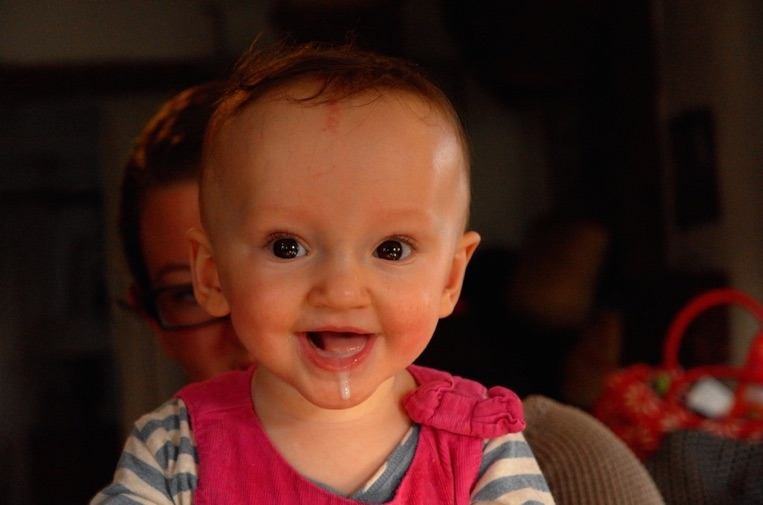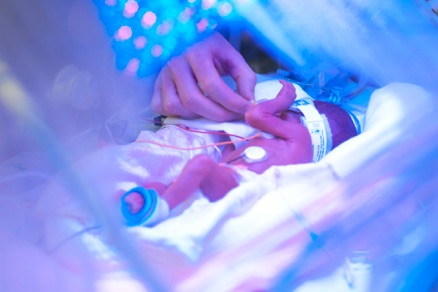GAS and Mirrorless - Revisited

GAS
Gear Acquisition Syndrome. This is a problem well known to the denizens of internet photographic forums. It’s a terrible and progressive disease in which photographic equipment accumulates exponentially. There is no known cure for it, certainly, the perfect camera with the perfect lens is a goad to more expenditure rather than the end of the road.
Mirror-less interchangeable lens cameras
This is a new type of camera which has interchangeable lenses, but does not have a mirror box like an SLR. Focusing is done straight from the sensor, either with an LCD or with an Electrical Viewfinder (EVF) (or both). The EVF has been much derided by photographers used to using an optical viewfinder, but it is gradually gaining favour as it’s possible to check the exposure, white balance etc. before taking your photograph. The advantages of these cameras is that you can use many different lenses from different systems (with an adapter), they are also usually smaller than SLR cameras.
Probably, if you didn’t know these things you shouldn’t be reading this either!
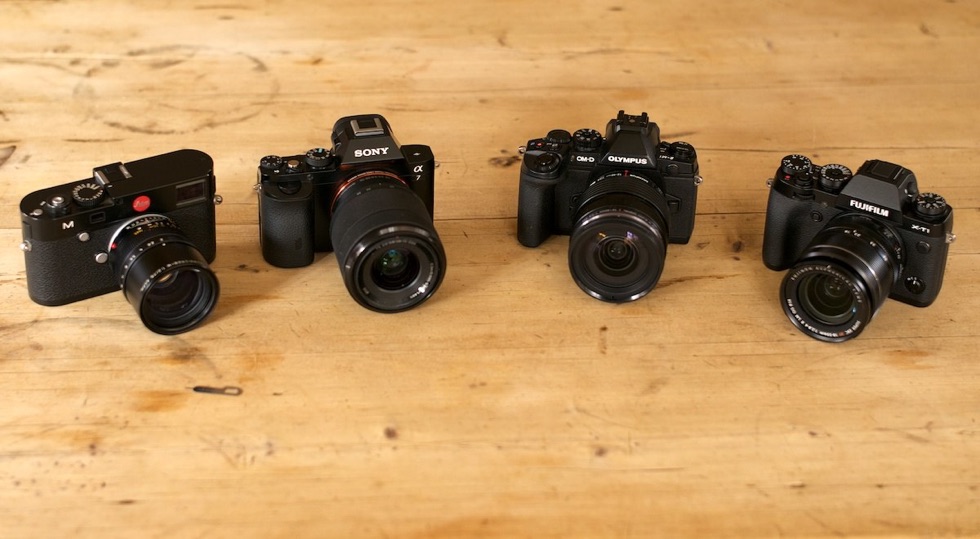
My GAS problem
I’ve been snapping away happily with a Leica rangefinder since the Leica M8 came out in 2006, I’ve collected 7 or 8 lovely lenses, and my wife keeps telling me that I take my best pictures with a rangefinder. I love the way you can see around the subject, and I love the way that the field of view through the viewfinder doesn’t change. I also like focusing manually. I’ve upgraded to the M9 and more recently the M(240) as they appeared. I couldn’t be happier with them, they make lovely files, they are lovely objects and a delight to use.
So - What’s the problem?
The problem is that I also want an Auto Focus camera with a zoom lens for casual photography and for when there isn’t time for changing lenses. Since I got the M8, I’ve lost count of the number of other cameras I’ve bought and used, but they include:
Nikon D3
Nikon D700
Sony A900
Pentax K7
Pentax K5
Panasonic G1
Sony NEX 7
Olympus Pen E-P1
Olympus OMD E-M5
Olympus OMD E-M1
FujiFilm X-T1
Sony A7r
Sony A7
The one thing all these cameras have in common is that they are capable of producing really good results. They each have their foibles, some I loved, some I hated, but they all came (and most of them went). After realising that Mirror-less cameras were the way forward I toyed with the Sony NEX system and the µ43 system, finally settling happily with µ43 when the OMD came out in 2012. I bought a lot of µ43 lenses and settled down to enjoy them. When the E-M1 appeared last autumn I excitedly upgraded.
Then Sony brought out the full frame A7 and A7r and my world fell apart - it seemed like a camera which could do everything - including using all my lovely M lenses, It was weather-sealed and delightfully small. I rushed out and bought an A7r and spent a weekend trying out my Leica lenses. Gradually I realised that they didn’t work as well as they did on the M, added to which the loud shutter noise on the A7r made hand holding much more difficult. At that point there were no Sony lenses to try out. I went back to my fixer, paid a small restocking charge and stepped away. Phew!
But then some lenses did appear, and my co-gas-addicts - (mostly at the GetDPI forum) were over the moon about the camera, added to which the Electronic First Shutter on the A7 seemed to make hand-holding more feasible. So I bought an A7 with the kit lens back in January. It’s first outing was a trip to Cornwall, where I quickly fell in love with the camera and the files.
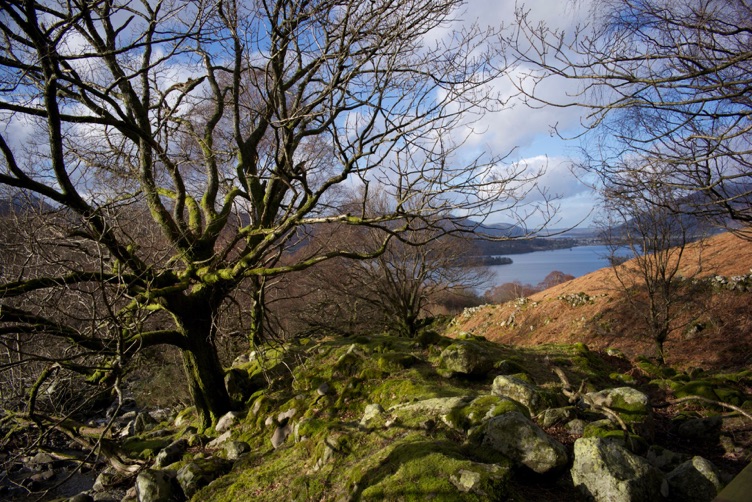
Derwent Water from near Ashness Bridge - with the Leica M
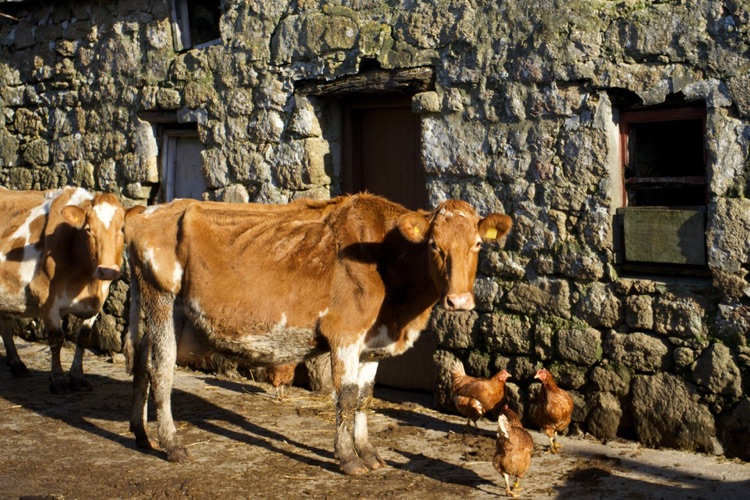
That Farmyard Look - Sony A7 with the 28-70 Kit Lens
By then I was beginning to realise that I must choose between my much loved Olympus µ43 kit and this new, full frame, Sony upstart. Then, dammit, FujiFilm announced the X-T1; a weather sealed camera with a big bright EVF, That Fuji Colour and all those analog buttons and knobs on the top plate. I couldn’t resist it and bought one as soon as they appeared in the UK. It was love at first sight.
This article is not relevant to you.
It is the sorry tale of a bad GAS attack, and my own personal way through the morass. Unfortunately any kind of camera decision is entirely personal, depending on your own priorities, photographic preferences and the depth of your pockets. I’m a long term Leica user, and the M in the picture above is simply to serve as a reference point, it is, and will remain for the foreseeable future the centre of my photographic world.
The three other cameras are the cause of my downfall!
I’m hoping that my affliction will serve as a warning to those not already caught up with this terrible problem - and perhaps a source of amusement to those who are. If you are hoping for a review of the cameras - stop now! There are plenty of excellent reviews of all three cameras scattered around the internet, I have no intention of re-inventing the wheel.
First of all, some definitions
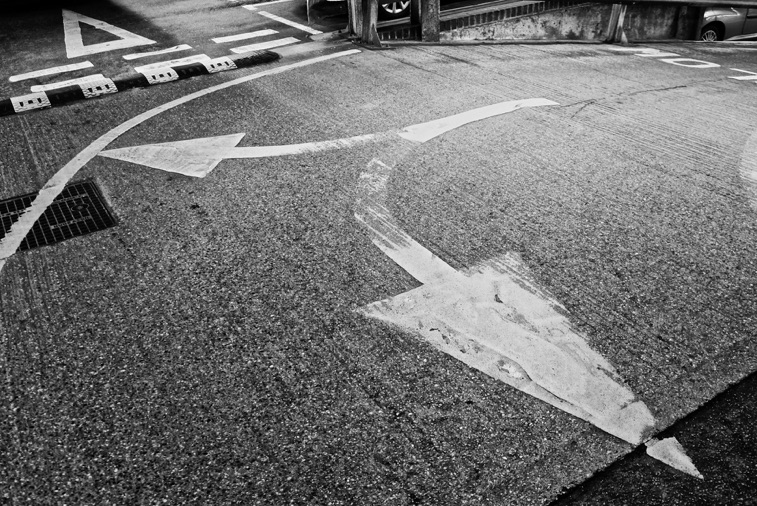
Which Way to Turn - the Fujifilm X-T1 with the 18-55 kit lens
Decision Time
Well, of course, I didn’t really have to decide, I could simply have kept all of them. But I want to get myself to the position where I have just the two systems - the Leica M system, and another system for use mostly with zoom lenses, loosely speaking it must be (in no particular order):
Satisfying to use
No compromise in image quality
Weather Sealed (I do live in England!)
with Good quality zoom lenses
Of course, all three of the cameras fulfill these qualities admirably (just read the glowing reviews on dPreview). Actually, they all three have some issues as well, at least, they have issues relevant to me personally. Please also note that one of the things I won’t change for any camera is the RAW processing program I use - which is Apple Aperture - I won’t go into a discussion as to why, but comments relating to image quality may not be relevant if you use another program
Problems with the Fuji
The clever new X-Trans sensor design has a tendency to produce smudgy greens under some circumstances
The lovely dials and knobs on the top plate are fantastic for changing settings when the camera is away from your eye - not so good when it isn’t
Problems with the Sony
The shutter is still noisier than I would like
The weather sealing doesn’t seem as convincing as the other two cameras
Problems with the Olympus
The menu system can be confusing - put the camera down for a fortnight and it’s hard to remember exactly what’s what
The files seem to lack something, despite excellent colour and definition.
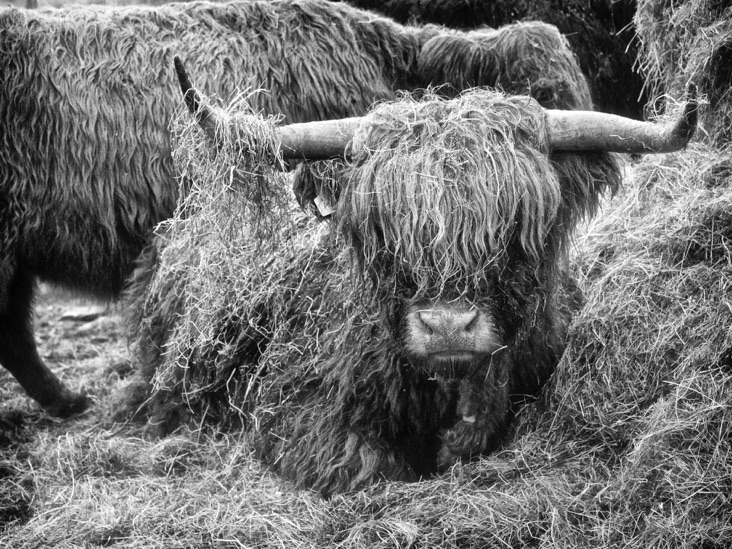
On the Horns of a Dilemma - the Olympus OMD E-M1 with the 12-40 f2.8 zoom
Anti-Climax - the Original Conclusion
Basically, the file quality of the Sony really is better than the other cameras (at least, it is in Aperture): not ALWAYS better, but usually better, easier to work with and with more satisfying colour, added to which the 24mp allows for more cropping, and the lure of 36mp with the A7r or it’s successor gives tantalising glimpses of the future.
Perhaps it’s also worth mentioning that of the cameras mentioned above, it was the Sony A900 that stayed the longest, probably because of the lovely colour and the ease of working with the files.
The A7 camera itself is great to shoot with - the menu system is huge, but I don’t need to delve into it that often. Then there is the killer punch - you can set the AE lock button to take a spot reading and hold it until you press the button again (perhaps you can do this with the other cameras, but I never did work it out). Little things please little minds.
Having a full frame camera to go with the Leica M is also an advantage, I used to think it was good to have the different sensor sizes, but actually it seems to make life easier just sticking to full frame - especially as I have one or two Leica R lenses which DO work well on the A7.
So - decision made, the Fuji has gone back and been exchanged for the Sony/Zeiss 24-70 F4 zoom, with some money left over to get the Sony 55 f1.8 (probably the only prime I’ll buy with the system). The µ43 kit will head off to ebay in the near future and this particular GAS attack will be over . . . . . . . .
Nearly a year ago, on April 26th our little grand-daughter Scarlett Rose was born. She was nearly 4 months early and weighed 1lb 10oz (740 grams). It was a terrifying experience for her parents (and her grandparents too). She spent 73 days in the Neonatal Intensive Care Unit at Norwich Hospital where she received the most wonderful care and attention from really dedicated staff.
One of Scarlett’s other two grandfathers has organised a 100 kilometre bicycle ride to raise money for NICU, and to celebrate Scarlett’s first birthday. This grandfather is duty bound to join in the ride! If you’ve enjoyed this article you might like to make a small donation to
Scarlett Rose Slack now.
Scarlett Rose Slack 1 day old.
Revisited - April 7th 2014
I’m afraid I must eat some humble pie, and possibly also my hat. If you read the original version of this page, you’ll remember the conclusion. Rather than change it, I’m going to follow along John Fowles (and others) and offer two possible conclusions (I’m sure there could just as well be a third as well).
In the process of getting equipment ready for sale on Ebay I decided to check my Olympus E-M1 to make sure that everything was working properly, so I grabbed the 12-40 zoom and my Leica R 80-200 f4 and took them out for a spin. The results were uniformly excellent, hence the second and alternative conclusion.
I’m having to eat my hat so many times that I’m considering a line of smoked salmon hats to make life easier, but changing my mind is in the spirit of the original article. For those who have been here before, the only change is the added conclusion.
The End
Except that
Anti-Climax - the Second Conclusion
Image Stabilisation
The file quality of the Olympus E-M1 may not be as splendid as that of the Sony - but it’s very close. The ability to use Image Stabilisation with ALL lenses is a real bonus, in the worst situation it allows 2 stops benefit to the Olympus, and in the best (and with 3rd party lenses) much more than that. This at least makes up for the limitations in ISO performance on the Olympus.
Print Sizes and Resolution
When Photo sites show the difference in sensor sizes (and also print sizes) the convention is to show 1/4 of the frame - this is perfectly okay BUT it exaggerates the difference in size between different sensors. In addition to this it’s natural to assume that a difference in resolution translates equally into a difference in print size. So that it’s easy to assume that if you can print to 24” with a 24mp sensor then you should be able to print to 36” with a 36mp sensor - of course, this isn’t the case, because the number of MP is a measurement of area, whereas print size is a linear measurement. In actual fact, if you can print to 36” with a 36MP sensor, then you can print to 30” with a 24MP sensor and 23” with a 16MP sensor. Like this:
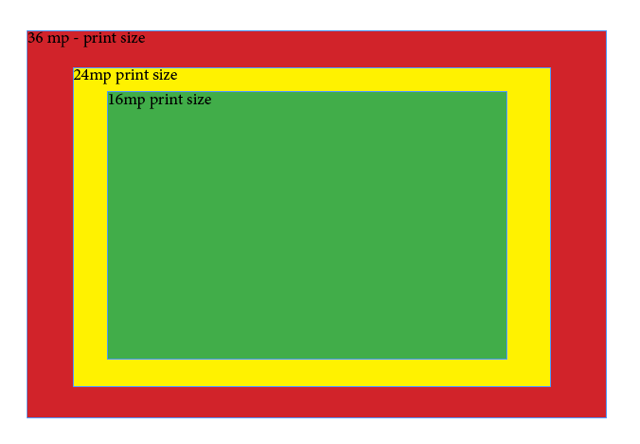
Ergonomics and Functionality
The E-M1 is just a joy to shoot with - the shutter noise is quiet and neat. In real world use the single shot AF is the fastest of the group - it may be that the Fuji is better at tracking, but the honest truth is that if you really need good tracking focus then you should still be using a big dSLR with a mirror. The EVF, although not as big as the Fuji is still big, and the contrast, colour and brightness seem to be best on the Olympus. The weather sealing is proved and excellent - certainly the Sony is less well sealed - the Fuji may be as good, but they don’t have the many years experience at this that Olympus have; certainly I’ve had the camera slung over my shoulder for 9 hours in heavy rain without any issues.
Telephoto lenses, Lens size and Depth of field
Although it’s often lovely to be able to limit depth of field for out of focus images, and this is best achieved with fast lenses on larger sensors, there are also times when it’s great to have a little more depth of field for shooting at longer focal lengths. Personally, if I want to do portraits and people with normal focal length lenses I’ll nearly always be using my Leica M - so it’s great to have a camera with a smaller sensor, especially for telephoto and macro.
Sensors will undoubtedly improve in the future, but the size of lenses is pretty much a fixed function of the sensor size, so that in the future we can expect better and better µ43 sensors, but there is unlikely to be a time when one can fit a 300mm f4 equivalent lens for full frame into a jacket pocket!
Native Lens Availability
At the time of writing WEX are offering 62 µ43 lenses for sale (and there are more coming). There are currently 4 FE lenses available. It isn’t just that though, with the sensor Image Stabilisation the Olympus can be used much more effectively with hundreds of 3rd party lenses, and although the 2x crop can sometimes be a disadvantage (with wide angles in particular) it can often be a real advantage.
So - decision made, the Fuji has gone back and the Sony equipment will be sent off to ebay in the near future. For my second camera system I’m going to use the Olympus E-M1 together with a small lens collection: 24-40 f2.8, 45 f1.8, 75 f1.8 and the 40-150 f2.8 zoom (when it arrives).
